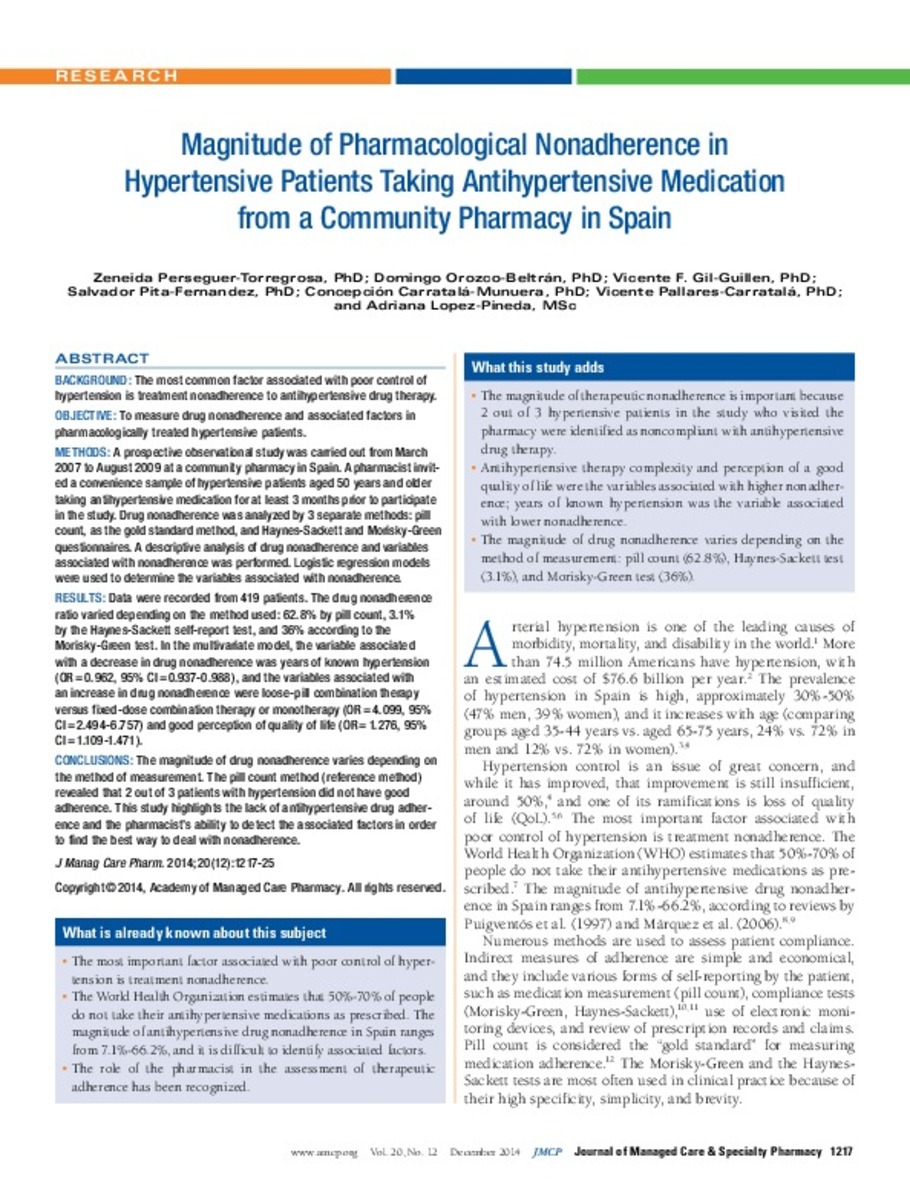Mostrar el registro sencillo del ítem
Magnitude of pharmacological nonadherence in hypertensive patients taking antihypertensive medication from a community pharmacy in Spain
| dc.contributor.author | Perseguer Torregrosa, Zeneida | |
| dc.contributor.author | Orozco Beltrán, Domingo | |
| dc.contributor.author | Gil-Guillén, Vicente F | |
| dc.contributor.author | Pita Fernández, Salvador | |
| dc.contributor.author | Carratalá Munuera, Concepción | |
| dc.contributor.author | Pallarés-Carratalá, Vicente | |
| dc.contributor.author | López Pineda, Adriana | |
| dc.date.accessioned | 2015-07-08T11:48:45Z | |
| dc.date.available | 2015-07-08T11:48:45Z | |
| dc.date.issued | 2014-12 | |
| dc.identifier.citation | PERSEGUER-TORREGROSA, Zeneida, et al. Magnitude of Pharmacological Nonadherence in Hypertensive Patients Taking Antihypertensive Medication from a Community Pharmacy in Spain. J Manag Care Pharm, 2014, 20.12: 1217-25. | ca_CA |
| dc.identifier.issn | 1083-4087 | |
| dc.identifier.uri | http://hdl.handle.net/10234/126774 | |
| dc.description.abstract | BACKGROUND: The most common factor associated with poor control of hypertension is treatment nonadherence to antihypertensive drug therapy. OBJECTIVE: To measure drug nonadherence and associated factors in pharmacologically treated hypertensive patients. METHODS: A prospective observational study was carried out from March 2007 to August 2009 at a community pharmacy in Spain. A pharmacist invited a convenience sample of hypertensive patients aged 50 years and older taking antihypertensive medication for at least 3 months prior to participate in the study. Drug nonadherence was analyzed by 3 separate methods: pill count, as the gold standard method, and Haynes-Sackett and Morisky-Green questionnaires. A descriptive analysis of drug nonadherence and variables associated with nonadherence was performed. Logistic regression models were used to determine the variables associated with nonadherence. RESULTS: Data were recorded from 419 patients. The drug nonadherence ratio varied depending on the method used: 62.8% by pill count, 3.1% by the Haynes-Sackett self-report test, and 36% according to the Morisky-Green test. In the multivariate model, the variable associated with a decrease in drug nonadherence was years of known hypertension (OR=0.962, 95% CI=0.937-0.988), and the variables associated with an increase in drug nonadherence were loose-pill combination therapy versus fixed-dose combination therapy or monotherapy (OR=4.099, 95% CI=2.494-6.757) and good perception of quality of life (OR=1.276, 95% CI=1.109-1.471). CONCLUSIONS: The magnitude of drug nonadherence varies depending on the method of measurement. The pill count method (reference method) revealed that 2 out of 3 patients with hypertension did not have good adherence. This study highlights the lack of antihypertensive drug adherence and the pharmacist’s ability to detect the ass | ca_CA |
| dc.format.extent | 9 p. | ca_CA |
| dc.format.mimetype | application/pdf | ca_CA |
| dc.language.iso | eng | ca_CA |
| dc.publisher | Academy of Managed Care Pharmacy | ca_CA |
| dc.relation.isPartOf | J Manag Care Pharm, 2014, 20.12 | ca_CA |
| dc.rights | Copyright ©2014, Academy of Managed Care Pharmacy. All rights reserved. (Non‐Commercial Academic Use Only) | ca_CA |
| dc.rights.uri | http://rightsstatements.org/vocab/InC/1.0/ | * |
| dc.subject | hypertension | ca_CA |
| dc.subject | drug nonadherence | ca_CA |
| dc.subject | hypertensive patients | ca_CA |
| dc.subject | Spain | ca_CA |
| dc.title | Magnitude of pharmacological nonadherence in hypertensive patients taking antihypertensive medication from a community pharmacy in Spain | ca_CA |
| dc.type | info:eu-repo/semantics/article | ca_CA |
| dc.rights.accessRights | info:eu-repo/semantics/openAccess | ca_CA |
| dc.relation.publisherVersion | http://www.amcp.org/WorkArea/DownloadAsset.aspx?id=18842 | ca_CA |
| dc.type.version | info:eu-repo/semantics/publishedVersion |
Ficheros en el ítem
Este ítem aparece en la(s) siguiente(s) colección(ones)
-
MED_Articles [671]
Articles de publicacions periòdiques







